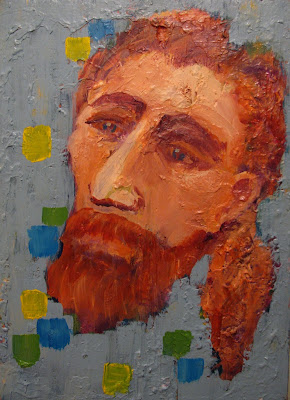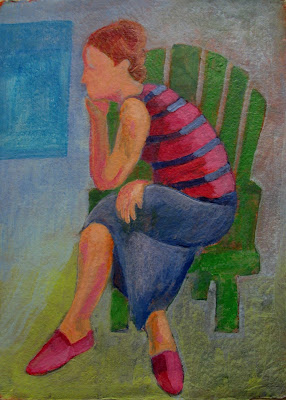As the year rolls on, I sometimes find myself thinking...Will this artist-of-the-week program ever end?! At first, I excitedly studied the blueprints. Then I found joy in the efforts of the early foundations. I gave myself a round of applause when I started to see the building rise above ground. I even announced a new wing. Yes, it continues to be a wonderful learning experience, but I just want to get through it and place a big check-mark against this item on my 2018 to-do list.
Well, even these feelings have precedents in art history -- or architectural history. No doubt you've heard of Gaudi's famous unfinished cathedral in Barcelona --still a work-in-progress after 127 years. And this building is just one among many famous or fabulous unfinished buildings -- check this link and, after Gaudi's Familia Sagrada, read at least about the second building on the list. Eerie.
Still: The hot and smoky month of August actually brought me to some cool artists, either new or only slightly familiar. The first, Alice Neel, is someone I plan to revisit. I *loved* her portrait "Elenka."
With this as my model, I tried to portray my young neighbour -- "Kristina."
Next, the coursework introduced artist David Cambria. Cambria's portraits would be almost conventional if he didn't smear and blotch and half-patch them over:
The strong features of his male models brought to mind a neighbour I occasionally chatted with before he moved away in the spring. I'd always thought he'd be a terrific subject to paint, and one day I made a quick memory sketch of his high cheekbones and deepset eyes.
INSERT BLOG 5 - sketch of guy down the street
With this and the example of Cambria's cover-ups, I managed a fair likeness. I call this "Palette Man" because I painted it on an old palette.
August's third artist, Richard Diebenkorn, was well known to me for his powerful drawings in several of my drawing books:
His paintings, I discovered, were powerful in a different way. He used beautiful, carefully modulated colours in broad almost abstract layouts, often portraying seated women. These recalled my own seated figures in my simple 2015 panel painting, "Not Far From SoMa" -- my first attempt to make a painting from preliminary quick sketches. I singled out this female figure as a Diebenkorn-type model:
-- to produce this spin-off:
The final artist-of-the-week (previously unknown to me), was Cathy Hegman who creates often blurred and "washed" images. It was one of her more defined figures, "Seekers", that drew my attention, particularly this detail:
In a fantastic coincidence, I'd discovered just the week before an amazing learning resource:-- Indiana University has collaborated with the famous Uffizi Gallery in Florence to create 3-D digitizations of the Gallery's sculptures and...ta tum!...they're all available on line. Do check in and give it a try -- just follow the cues to be able to rotate the piece in space: all the way around, and in every vertical orientation. (If you discover how to do somersaults, please let me know).
I chose the marble bust of the goddess "Cybele" and worked from the on-line image to emulate Hegman's figure.
Wow. Just reliving some of these challenges I set for myself has been energizing. I've learned a lot this month and found some exciting byways to pursue in future studies. Hard to say whether the creators of all those unfinished buildings felt the same way, but right now I'm recalling the wisdom of the familiar mantra: "The journey is the destination."

























